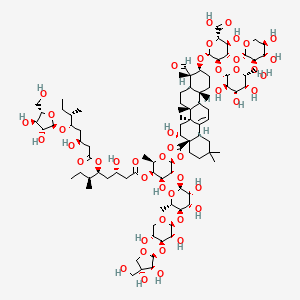2 Identification
2.1 Computed Descriptors
2.1.1 IUPAC Name
(2S,3S,4S,5R,6R)-6-[[(3S,4S,4aR,6aR,6bS,8R,8aR,12aS,14aR,14bR)-8a-[(2S,3R,4S,5R,6R)-3-[(2S,3R,4S,5R,6S)-5-[(2S,3R,4S,5R)-4-[(2S,3R,4R)-3,4-dihydroxy-4-(hydroxymethyl)oxolan-2-yl]oxy-3,5-dihydroxyoxan-2-yl]oxy-3,4-dihydroxy-6-methyloxan-2-yl]oxy-5-[(3S,5S,6S)-5-[(3S,5S,6S)-5-[(2R,3R,4R,5S)-3,4-dihydroxy-5-(hydroxymethyl)oxolan-2-yl]oxy-3-hydroxy-6-methyloctanoyl]oxy-3-hydroxy-6-methyloctanoyl]oxy-4-hydroxy-6-methyloxan-2-yl]oxycarbonyl-4-formyl-8-hydroxy-4,6a,6b,11,11,14b-hexamethyl-1,2,3,4a,5,6,7,8,9,10,12,12a,14,14a-tetradecahydropicen-3-yl]oxy]-3-hydroxy-5-[(2S,3R,4S,5R,6R)-3,4,5-trihydroxy-6-(hydroxymethyl)oxan-2-yl]oxy-4-[(2S,3R,4S,5R)-3,4,5-trihydroxyoxan-2-yl]oxyoxane-2-carboxylic acid
2.1.2 InChI
InChI=1S/C92H148O46/c1-13-36(3)46(126-54(102)25-41(98)24-47(37(4)14-2)127-80-62(110)58(106)49(30-94)128-80)23-40(97)26-55(103)131-69-39(6)125-82(73(65(69)113)136-79-64(112)60(108)68(38(5)124-79)132-78-67(115)70(45(100)32-122-78)133-84-75(116)91(120,34-96)35-123-84)138-85(119)92-22-21-86(7,8)27-43(92)42-15-16-51-87(9)19-18-53(88(10,33-95)50(87)17-20-89(51,11)90(42,12)28-52(92)101)130-83-74(137-81-63(111)59(107)57(105)48(29-93)129-81)71(66(114)72(135-83)76(117)118)134-77-61(109)56(104)44(99)31-121-77/h15,33,36-41,43-53,56-75,77-84,93-94,96-101,104-116,120H,13-14,16-32,34-35H2,1-12H3,(H,117,118)/t36-,37-,38-,39+,40-,41-,43-,44+,45+,46-,47-,48+,49-,50+,51+,52+,53-,56-,57-,58-,59-,60-,61+,62+,63+,64+,65-,66-,67+,68-,69-,70-,71-,72-,73+,74+,75-,77-,78-,79-,80+,81-,82-,83+,84-,87-,88-,89+,90+,91+,92+/m0/s1
2.1.3 InChI Key
DRHZYJAUECRAJM-DWSYSWFDSA-N
2.1.4 Canonical SMILES
CCC(C)C(CC(CC(=O)OC(CC(CC(=O)OC1C(OC(C(C1O)OC2C(C(C(C(O2)C)OC3C(C(C(CO3)O)OC4C(C(CO4)(CO)O)O)O)O)O)OC(=O)C56CCC(CC5C7=CCC8C9(CCC(C(C9CCC8(C7(CC6O)C)C)(C)C=O)OC1C(C(C(C(O1)C(=O)O)O)OC1C(C(C(CO1)O)O)O)OC1C(C(C(C(O1)CO)O)O)O)C)(C)C)C)O)C(C)CC)O)OC1C(C(C(O1)CO)O)O
2.1.5 Isomeric SMILES
CC[C@H](C)[C@H](C[C@@H](CC(=O)O[C@@H](C[C@@H](CC(=O)O[C@H]1[C@H](O[C@H]([C@@H]([C@H]1O)O[C@H]2[C@@H]([C@@H]([C@H]([C@@H](O2)C)O[C@H]3[C@@H]([C@H]([C@@H](CO3)O)O[C@H]4[C@@H]([C@](CO4)(CO)O)O)O)O)O)OC(=O)[C@]56CCC(C[C@H]5C7=CC[C@@H]8[C@]9(CC[C@@H]([C@@]([C@@H]9CC[C@]8([C@@]7(C[C@H]6O)C)C)(C)C=O)O[C@H]1[C@@H]([C@H]([C@@H]([C@H](O1)C(=O)O)O)O[C@H]1[C@@H]([C@H]([C@@H](CO1)O)O)O)O[C@H]1[C@@H]([C@H]([C@H]([C@H](O1)CO)O)O)O)C)(C)C)C)O)[C@@H](C)CC)O)O[C@H]1[C@@H]([C@H]([C@@H](O1)CO)O)O
2.2 Other Identifiers
2.2.1 UNII
2.3 Synonyms
2.3.1 MeSH Synonyms
1. Qs 21
2. Qs-21
3. Qs21
4. Saponin Qa-21v1
5. Sq 21a
2.3.2 Depositor-Supplied Synonyms
1. Qs 21
2. Qa 21v1
3. 3lhl0s9kbm
4. Qs-21-api
5. Qs21
6. Saponin Qa 21v1
7. Saponin Qa-21v1
8. Qa 21
9. Unii-3lhl0s9kbm
10. Qs-21-apiose Isomer
11. Qs 21 [who-dd]
12. Qa-21v1
13. Qs-21v1
14. Dtxsid601318719
15. Hy-101092
16. Cs-0020802
2.4 Create Date
4 Pharmacology and Biochemistry
4.1 MeSH Pharmacological Classification
Adjuvants, Immunologic
Substances that augment, stimulate, activate, potentiate, or modulate the immune response at either the cellular or humoral level. The classical agents (Freund's adjuvant, BCG, Corynebacterium parvum, et al.) contain bacterial antigens. Some are endogenous (e.g., histamine, interferon, transfer factor, tuftsin, interleukin-1). Their mode of action is either non-specific, resulting in increased immune responsiveness to a wide variety of antigens, or antigen-specific, i.e., affecting a restricted type of immune response to a narrow group of antigens. The therapeutic efficacy of many biological response modifiers is related to their antigen-specific immunoadjuvanticity. (See all compounds classified as Adjuvants, Immunologic.)



